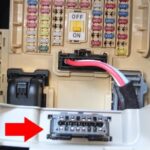Navigating the world of automotive diagnostics can be tricky, especially when dealing with vehicles from the mid-1990s. A common question arises for owners of the 1994 Chevy 2500 pickup truck: is it equipped with the older OBD1 system or the more modern OBD2? This question is crucial for anyone looking to use diagnostic scan tools to troubleshoot engine issues or understand their vehicle’s health. Let’s delve into how to determine the OBD system on your 1994 Chevy 2500 and clear up any confusion.
Understanding the OBD System Uncertainty in 1994 Chevy 2500 Models
The 1994 model year falls into a transitional period in automotive diagnostic standards. While OBD2 was federally mandated for all cars and light trucks starting in 1996, some manufacturers began incorporating OBD2 components earlier. This is where the confusion often stems from. Owners might find elements that appear to be OBD2 compliant, such as a 16-pin Diagnostic Link Connector (DLC), leading them to believe their 1994 Chevy 2500 is fully OBD2. However, appearances can be deceiving.
Identifying Your 1994 Chevy 2500’s OBD System: The DLC Inspection
One of the first steps in identifying your OBD system is to locate and inspect your Diagnostic Link Connector (DLC). While a 16-pin DLC is characteristic of OBD2, its presence alone doesn’t guarantee full OBD2 compliance in a 1994 vehicle. The key is to compare your DLC with known OBD1 and OBD2 configurations.
Example of an OBD1 DLC Connector (Illustrative)
If your DLC closely resembles the OBD1 style connector, it’s highly likely your 1994 Chevy 2500 utilizes an OBD1 system, despite any visual similarities to OBD2 connectors in the dash area. To be absolutely certain, further investigation is needed.
Leveraging the VIN and RPO Codes for OBD System Clarity
Beyond visual inspection, your Vehicle Identification Number (VIN) and Regular Production Option (RPO) codes can provide valuable insights. Decoding your VIN can confirm the year and model of your truck, engine type, and assembly plant. In the case of the 1994 Chevy 2500, a VIN decode will definitively confirm it as a 1994 model.
Furthermore, checking the RPO codes, typically found on a sticker in the glove box, can reveal specific factory-installed options and potentially shed light on the vehicle’s diagnostic system. While RPO codes may not directly state “OBD1” or “OBD2”, they can provide clues about the electronic control systems used in your specific truck.
Considering Vehicle History and Potential Modifications
In some instances, discrepancies between the expected OBD system and what’s actually present can arise from vehicle modifications or repairs. The original forum post raises an interesting point about potential cab swaps. If a 1994 Chevy 2500 underwent significant repairs, involving a cab replacement from a different year model (e.g., a 1996 cab), it’s conceivable that some components, including dash elements, might have been swapped.
Checking a vehicle history report can uncover past accidents, repairs, or title issues that might support the theory of a cab swap or other significant modifications. Additionally, physically inspecting other VIN locations on the vehicle (beyond the dashboard) can help verify the consistency of the VIN and identify potential discrepancies.
Conclusion: Determining Your 1994 Chevy 2500 OBD System
Pinpointing the exact OBD system in a 1994 Chevy 2500 requires a multi-faceted approach. Start by carefully examining your DLC and comparing it to OBD1 and OBD2 standard connectors. Utilize your VIN for decoding and check RPO codes for factory configuration details. Finally, consider the vehicle’s history for any signs of modifications that might explain any OBD system ambiguities. By systematically investigating these areas, you can confidently determine whether your 1994 Chevy 2500 is operating with an OBD1 or a potentially early, partial OBD2 system, ensuring you use the correct diagnostic procedures and tools for any necessary maintenance or repairs.
